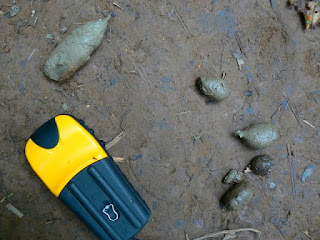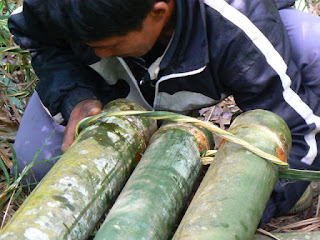Tui makes a last phone call while still within range of phone tower.
The trail to Nambo is a relative superhighway. It is by far the most gradual and fastest trail for hundreds of square miles. Using the cut of the the Nam Long through the mountains the trail steadily gains elevation while never resorting to switchbacks or steep sections. I've walked the trail twice, once back in 06 and more recently in the winter of 09. The trail provides easy access to the upper drainage of the Nam Fa. The trail is also used by all the Lao Sung as a quick access to the market at Muang Long. Bear in mind that tiny market is the biggest one in north western Laos beyond Muang Sing, and Burma across the river is even less traveled, it's a long way upriver to China or down to Thailand.
In 06 I saw the tracks of a single motorcycle made at the beginning of the dry season. I think it was a rider from that GT Riders club out of Chang Mai Thailand. They would of had to have pushed and drug the bike up and down many of the numerous stream crossings. None of the villages have motorcycles or other transport. I assume it was an off road bike, one of the last to have made the transect to Viengphouka. A few years ago there were temporary bridges strong enough to drive on with one of those one cylinder Chinese tractor things. The bridges were made by felling two large logs across the streams and covering the logs with branches and then mud and dirt. The logs have rotted away and are gone. Now there are small single slippery logs strong enough to support a person. I'd think it would more time and effort now to drag and carry a motorcycle up and down the many stream crossings than to just walk.
Stream Crossing
If you look on maps they show the trail as a full fledged road to Viengphouka, maybe it was in some one's imagination once, and it certainly might be at some future date, but for now it's falling back into forest. The dirt was hacked out of the hillside to make a flat graded path, and it was never wide enough for a two track even when new.
Google Earth-mountains beyond mountains beyond mountain
I don't know where the funding to work on upgrading the original trail came from. I've seen road crews making similar tracks. Fifty people hacking at the hillside with those heavy hoes they use to farm. Was this one of the many plans for crop substitution? A way to bring crops or forest products to market? Tui from the tourism office asked me if I thought it was 20 kilometers. I guess so, I'm not the best at figuring kilometers, feels like ten miles anyway, maybe twelve or more. The road roughly follows the south side of the Nam Long but high above the river. I'm not sure of the elevation gain but it does go up all the way to Ban Nambo. There's a village somewhere, down by the river I suspect, I've never been there.
Stile
At the near end of the trail there are fences to keep cattle from wandering.. In English we call these fences "stiles". A person can walk up the ladder, an animal can't. The hillside drops off so steeply on both sides that the cattle are restricted to the road. As the kilometers pass under our feet most signs of people also pass. Soon we are beyond the distance that most people will reasonably walk to go hunting or gather stuff to sell at the market.

Bamboo in flower?
I stopped and looked at animal tracks, Tui thought them wild pig and large deer. People sometimes drive a cow or a pig in to town to sell for cash money, and the tracks might well have been from them, yet I hadn't seen any other tracks on the walk. In the forests around my house I recognise differences between the tracks of the deer, elk, moose, and domestic cow, in Laos not so much, even the cows are different. Guang yai (Sambar) are still around even if not as common as the smaller muntjak, and certainly wild pigs are plentiful. A carnivore scat had me guessing. There are two kinds of big cats and two canines, and two species of bear.
gps and carnivore scat
Pig Droppings
I was sure it wasn't one of the two canines, too small, and not tapered at the end. The larger of the canines is called Ma Nhai as I remember (in Lowland Lao Language). I remembered it because of it's similarity to Ma Hai which is mad dog which of course I'd never use to describe a person, maybe I have it wrong anyway, and the peoples who live where the Ma Nhai lives speak other languages than Vientiane Lao so who knows what it's really called. We call it Dhol, and there is no love lost between the upland peoples and the dhol, not only because of the mutual competition for food.

Dhole from a camera trap by the WCS
The Dhol hunts in packs similar to our wolf, overwhelming it's quarry by sheer numbers and beginning their feasts by ripping out and eating the guts of the often still alive prey. Akha I talked to said they will bite people, no wonder they don't like the dhol. Bear droppings can vary, mostly I've seen bear scat when they are feeding on grubs, ants, and berries, or grass in the spring, this didn't look like either.Clouded Leopard from the WCS
That leaves cat, which kind of goes with it's not twisted shape and no sign of vegetables. I've no way to tell the cats apart or even hazard a guess except that it had to be one big enough to eat deer. Immature tiger or leopard or clouded leopard?Concrete Bridge. The most ambitious structur of the trail.
Past half way to Nambo is a landmark. A concrete bridge over the largest tributary to the Nam Long on the trail. We stop for a break and to eat the barbecued dove and sticky rice I bought in the market the night before. We eat the whole thing bones and all, I think Tui spit out the skull.Well before dusk we begin to hear chickens and the trail once again is worn by the steps of many feet.
I hear children, smell smoke.
Through the trees, Nambo.
First Glimpse































































